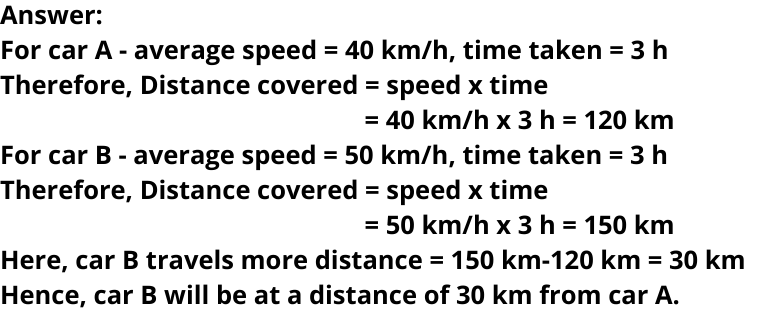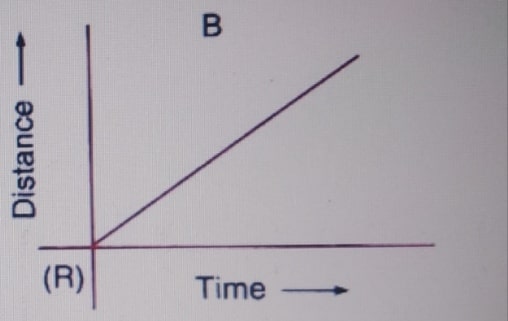Are you looking for DAV Books Solutions then you are in right place, we have discussed the solution of Science class 7 book Chapter 6 Motion and Time which is followed in all DAV School Solutions are given below with proper Explanation please bookmark our website for further updates!! All the Best !!
DAV Class-8 Motion and Time Question and Answer
Something To Know
A. Fill in the blanks.
1. An object is said to be at rest if it ___________ change its position with time.
2. The SI unit of time is ___________.
3. A child, sitting in a revolving giant wheel, is an example of a ___________ motion.
4. A car, moving on a busy straight road, is an example of ___________ motion.
5. The speedometer of a motorbike measures its speed in ___________.
Answer: (1) does not (2) second (3) circular (4) non uniform or linear (5) km/h
B. Write True or False for the following statements.
| Questions | Answer (True/False) |
| 1. The speed of a fast moving train is usually measured in metre per hour. | False |
| 2. The average speed remains constant for an object having a uniform motion. | True |
| 3. A man walks for 1 minute, at a speed of 1 m/s, along a straight track. The total distance covered by him is 1 m. | False |
| 4. An object, moving along a straight line, is said to be in uniform motion if it covers regularly increasing distances in equal intervals of time. | False |
| 5. The time period of a simple pendulum, which takes 42 seconds to complete 20 oscillations, equals 2.1 seconds. | True |
| 6. The distance-time graph, for a car kept parked on a side road, is a straight line parallel to the time axis. | True |
Answer: (1) False (2) True (3) False (4) False (5) True (6) True
C. Tick the correct option.
1. Out of the following, the only correct formula is—
Ans 1. distance = speed x time
2. A man walks on a straight road from his home to a market 3 km away with a speed of 6 km/h. The time, taken by the man to go from his home to market, equals-
Ans 2. 30 minutes
3. The odometer of a car reads 57321.0 km when the clock shows the time as 8.30 a.m. The odometer reading changes to 57336.0 km at time 8.50 a.m. The distance, moved by the car, in these 20 minutes, equals—
Ans 3. 15 km
4. Out of the following distance-time graphs, the graph that represents a truck at rest, is the graph labelled—
Ans 4.

5. In the given diagram of a simple pendulum, the time taken by the bob to move from X to Z is ‘t1‘ and from Z to O is ‘t2‘. The time period of this simple pendulum is-

Ans 5. 4 (t1+t2)
6. The S.I. unit of speed is-
Ans 6. m/second
D. Answer the following questions in brief.
Q. 1. A boy walks to his school with a constant speed of 4 km/h and reaches there in 30 minutes. Find the distance of the school from his house.
Ans 1: Speed = 4 km/h
Time taken = 30 minutes = ½ h = 0.5 h
Therefore,
Distance = speed x time
= 4 km/h x ½ h
= 2 km
Hence, The distance of school from his house is 2 km.
Q. 2. The distance between two stations is 216 km. A bus takes 4 hours to cover this distance. Calculate the average speed of the bus in km/hour.
Ans 2: Distance = 216 km
Time taken = 4h
Therefore,
Average speed = Total distance covered/total
time taken = 216 km/4h = 54 km/h
Q. 3. Two Cars, A and B. (starting, at the same time, from the same point) are moving with average speeds of 40 km/h and 50 km/h, respectively, in the same direction. Find how far will Car B be from Car A after 3 hours.

Q. 4. A car moves with a speed of 40 km/h for 15 minutes and then with a speed of 60 km/h for the next 15 minutes. Find the total distance covered by the car in these 30 minutes.
Ans 4: Distance covered in 1st 15 minutes = 40 km/h x 15 minutes
= 40 km/h x ¼ h
= 10 km
Distance covered in 2nd 15 minutes = 60 km/h x 15 minutes
= 60 km/h x ¼ h
= 15 km
Therefore, Total distance covered = 10 km + 15 km
= 25 km
Q. 5. Define the term ‘Periodic motion. Give two examples of periodic motions that can be used to measure time.
Ans 5: Periodic motion – motion, which repeats itself after a regular interval of time, is called periodic motion.
Examples: (1) motion of the hands of a clock.
(2) motion of the moon around the earth.
Q. 6. Distinguish between uniform and non-uniform motion. Give one example of each.
Ans 6: Uniform motion: An object is said to be in uniform motion when it moves along a straight path and covers equal distances in equal intervals of time, howsoever small these intervals of time maybe.
Example: Motion of a body along a straight path covering equal distances in equal intervals of time.
Non-uniform motion: When an object, (1) moving along a straight path, covers unequal distances in equal intervals of time or (2) does not move along a straight path, its motion is called a non-uniform motion.
Example: Motion of a free-falling object.
Q. 7. Draw the shape of distance-time graph for:
(a) a man, waiting for a bus, standing at one point, on a bus-stand.
Ans 7:

(b) a man, walking on a level, straight and narrow road, with a constant speed.
Answer:

E. Answer the following questions.
1. A farmer moves along the boundary of a rectangular field ABCD as shown in the figure. He takes 4 minutes to travel across each side.

Is the motion of this farmer uniform or non-uniform? Find his average speed over one complete round of the field.
Ans 1: Motion of the farmer – non-uniform, as he covers unequal distances in equal intervals of time.
Average speed of the farmer = total distance covered/time taken
= 240 m/16 min.
= 240 m / 960 seconds {change min. into second}
= ¼ m/s
= 0.25 m/s
2. During rainy season, Shivam noted that the thundering sound of clouds was heard 6 seconds after the lightening was seen by him. If speed of sound in air is 340 m/s, find the distance of the point where the thundering sound was produced.
Ans 2: Speed of sound = 340 m/s
Time taken = 6 seconds
Therefore, distance = 340 m/s x 6 seconds
= 2040 m
= 2.04 km
Hence, thundering sound was produced at a distance of 2.04 km from Shivam.
3. (a) How can we make a simple pendulum?
(b) A simple pendulum takes 10 seconds to complete 5 oscillations. Find the time period of this pendulum.
Ans 3: (a) A simple pendulum can be made by a metal ball attached to taut light string, or thread, that is fixed rigidly at one end.
(b) Number of complete oscillations = 5
Total time taken = 10 seconds
Time period of the pendulum = 10/5 = 2 seconds
4. Carefully examine the data given below for motion of two different objects A and B. State whether the motion of these two objects is uniform or non-uniform.

Ans 4: Object A is in uniform motion as it covers equal distances in equal intervals of time.
Object B is in non-uniform motion as it does not cover equal distances in equal intervals of time
5. Observe the graph given here. From the graph, find (i) the values o distances ‘P’ and ‘Q’ in ‘m’ and (ii) the value of time ‘R’ in ‘seconds’.

Ans 5: (1) Value of ‘P’ = 3 m, Value of ‘Q’ = 12 m
(2) Value of ‘R’ = 12 seconds